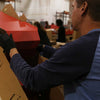

In an increasingly globalized economy, tariffs have become a major consideration for companies across industries.
For businesses that rely on custom packaging and POP Displays, shifting international trade policies and rising tariffs can significantly affect costs, timelines, and overall strategy. Understanding how tariffs impact your supply chain, materials, and production methods is essential to remain competitive and responsive in today's market.
Tariffs are government-imposed duties on imported goods. While they are often implemented to protect domestic industries, they can also increase the cost of raw materials, limit access to international suppliers, and disrupt production schedules.
These effects are especially pronounced in the packaging and retail display industry, where a combination of custom design, sourcing flexibility, and speed to market are critical success factors.
Table Of Contents
Rising Tariffs and Their Effect on Custom Packaging
Due to recent tariffs on goods from countries like China, the cost of materials used in packaging, such as paperboard, corrugated cardboard, aluminum, and certain plastics, has increased.
For many brands, this has led to higher production costs and tighter margins. When materials are imported or even partially sourced from abroad, the overall expense of creating custom packaging rises substantially.
Custom packaging often requires specialized inks, coatings, and finishes that may also be sourced internationally. Tariffs on these materials compound the cost issue.
Additionally, many companies depend on overseas partners for advanced printing or lamination capabilities that are not readily available domestically.
When tariffs increase the cost of importing these components, companies are forced to either absorb the additional cost or pass it along to their customers.
POP Displays (point—of—purchase Displays) —are also impacted. These displays are typically large, three-dimensional, and composed of multiple materials, including cardboard, plastic, metal, and foam.
Sourcing these materials internationally has long been a cost-effective strategy, but tariff hikes have changed the equation.
POP Displays: Design Flexibility Meets Global Trade Barriers
POP Displays play a vital role in retail by capturing shoppers' attention and driving impulse buys. However, when tariffs drive up the cost of components and materials, businesses may be forced to reduce their display creativity or scale.
The reality is that custom packaging and POP Displays are no longer just aesthetic tools—they are crucial for storytelling, brand identity, and consumer experience. Limiting creativity due to budget constraints imposed by tariffs can have downstream effects on customer engagement and sales.
To maintain quality while controlling costs, businesses increasingly source materials domestically, automate certain production stages, or redesign displays to use fewer or alternative materials.
Some companies are also working more closely with suppliers to forecast pricing fluctuations or lock in costs ahead of tariff adjustments.
Packaging suppliers who offer domestic manufacturing with digital capabilities—such as on-demand printing and short runs—are becoming more valuable. They allow for speed and customization while eliminating overseas shipping fees and delays.
Strategic Adjustments to Navigate Tariff Challenges
To adapt to ongoing tariff volatility, businesses must rethink their packaging and retail display strategies. One critical shift has been the increased demand for digital printing solutions.
With digital presses, brands can bypass traditional litho-label or plate requirements, saving time and material costs. This especially benefits companies running multiple SKUs, seasonal promotions, or region-specific campaigns.
Short-run custom packaging is now more viable than ever. Tariffs often make large overseas bulk orders less attractive, encouraging smaller, more flexible runs closer to home. This not only reduces risk but also empowers marketing teams to test campaigns faster and with less investment.
POP Displays benefit from similar digital advantages. Brands can create regionally unique designs, tailor graphics to seasonal messaging, or adjust quantities with little lead time.
All of these benefits align with the modern retail environment, which favors agility and innovation.

Redefining Supply Chains for Resilience
The traditional global supply chain model is under pressure. More businesses are recognizing the value of diversification—sourcing from multiple regions or developing dual production pathways to mitigate the risk of tariff spikes. This includes a renewed focus on U.S.-based packaging production.
Some companies are turning to packaging providers who can handle everything in-house—from concept and structural design to printing, pack-out, and distribution.
This vertically integrated model reduces touchpoints, improves coordination, and helps brands stay nimble in uncertain markets.
There’s also been a noticeable increase in interest in sustainable packaging materials that are locally sourced. Not only does this reduce tariff exposure, but it also aligns with growing consumer demand for eco-conscious products. Kraft board, recycled corrugate, and water-based inks are not only tariff-safe but also brand-enhancing.
Final Thoughts
Tariffs have added new complexity to the world of custom packaging and POP Displays, but they’ve also prompted a wave of innovation. Companies that view these challenges as opportunities to rethink sourcing, streamline operations, and invest in domestic capabilities are positioning themselves for long-term success.
Whether through digital transformation, sustainable sourcing, or reshoring strategies, the goal remains the same: deliver high-impact packaging and displays that drive sales and build brand loyalty—without being at the mercy of global trade fluctuations.
POP Displays and custom packaging are more than just marketing assets; they are critical touchpoints in the consumer journey. By planning strategically and partnering with forward-thinking suppliers, businesses can thrive in a post-tariff landscape.
How Bennett Can Help
At Bennett, we specialize in custom packaging and POP Displays that are designed, printed, and produced right here in the U.S. Our vertically integrated services—from concept through distribution—help you avoid overseas delays, manage costs, and bring your brand to life with speed and precision.
Let’s build smarter solutions together.
Contact our team today to explore how Bennett can support your next project with scalable, tariff-resistant strategies that keep you competitive.




